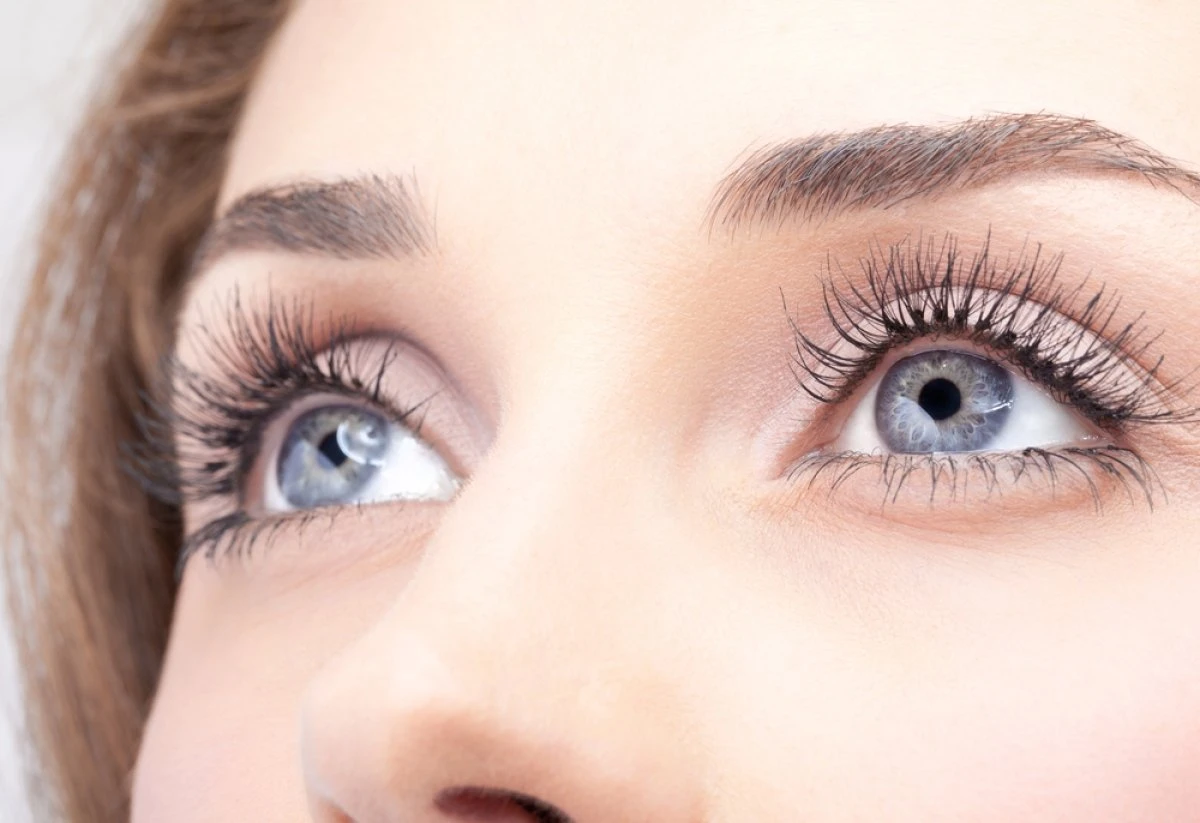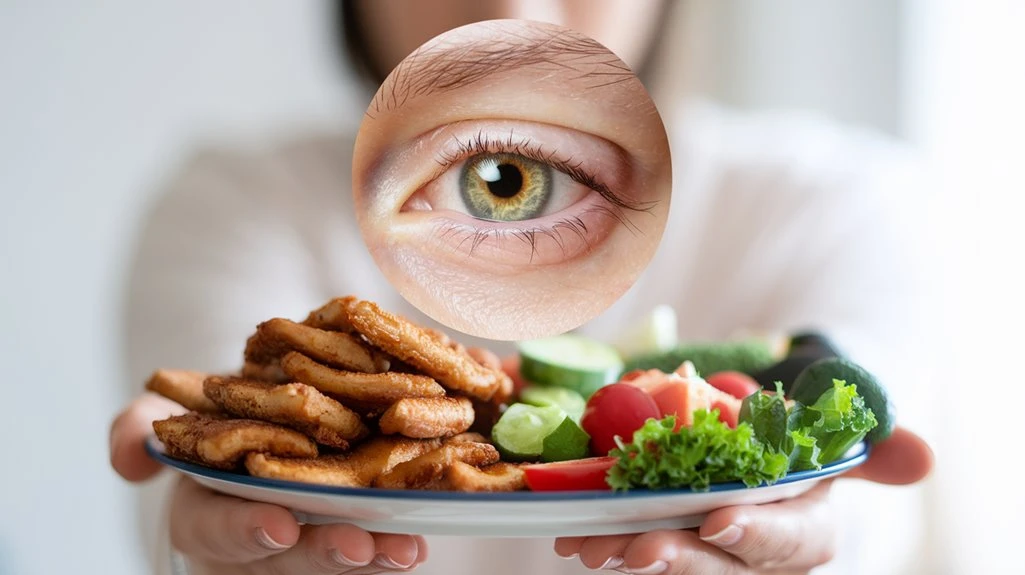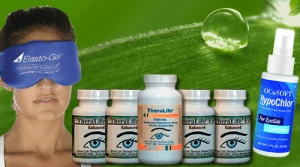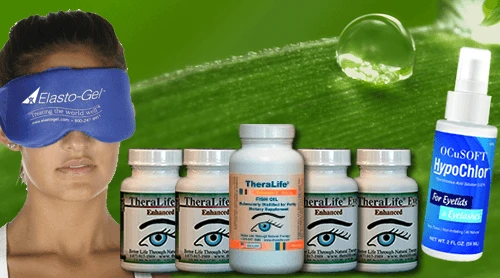If you have blepharitis, avoiding certain foods like high sugar, refined carbohydrates, processed foods, and alcohol is crucial because they can increase systemic inflammation and exacerbate eyelid irritation. Additionally, allergens such as dairy may trigger immune responses, further inflaming the area. Fried and greasy foods can disrupt meibomian gland function, aggravating symptoms. Understanding which dietary factors affect your ocular health is essential for optimizing eyelid management.
TheraLife’s products offer significant benefits for those dealing with blepharitis and other eye conditions. They provide natural, effective solutions to reduce inflammation and improve eye health. TheraLife products are designed to enhance ocular comfort and promote healing, offering a comprehensive approach to managing symptoms and improving quality of life for their customers.
Best Blepharitis Treatment From TheraLife- When Drops Don’t Work.
Key Takeaways
- Certain foods may increase systemic inflammation, potentially exacerbating blepharitis symptoms in some individuals.
- Processed, fried, or sugary foods can trigger low-grade inflammation, negatively impacting overall ocular surface health.
- Some people have food sensitivities or allergies that can worsen eyelid inflammation through immune responses.
- Minimizing refined carbohydrates and alcohol can support healthier tear production and reduce inflammatory pathways.
- Prioritizing a balanced diet helps maintain general eye health, even though diet alone cannot treat blepharitis.
Understanding the Connection Between Diet and Blepharitis
Although dietary factors influence many aspects of ocular health, current clinical evidence doesn’t support a direct connection between diet and the development or exacerbation of blepharitis. You’ll find that clinical trials and epidemiological studies examining dietary habits haven’t established a causal link with blepharitis incidence or severity. While nutritional deficiencies—such as inadequate intake of vitamins A, D, or omega-3 fatty acids—are associated with general eye dysfunction, their role in the pathogenesis of blepharitis remains unsubstantiated. Practitioners recommend maintaining a balanced diet to support overall ocular surface integrity, but nutritional therapies aren’t considered first-line interventions for blepharitis management. As a result, modifying your dietary habits alone is unlikely to greatly impact blepharitis outcomes; instead, evidence-based therapies remain the mainstay of treatment. However, for individuals dealing with Sjögren’s syndrome, an autoimmune diet may help alleviate symptoms by reducing inflammation, although it is not directly linked to blepharitis.
Sugar Intake and Its Effects on Eyelid Inflammation
While elevated sugar consumption adversely affects systemic inflammatory pathways and metabolic health, current clinical research doesn’t demonstrate a direct association between dietary sugar intake and increased eyelid inflammation specific to blepharitis.
You should recognize that high glycemic diets may contribute to generalized systemic inflammation, but evidence linking sugar intake specifically to blepharitis pathophysiology remains inconclusive.
Excessive sugar can promote hyperglycemia and insulin resistance, creating an environment conducive to chronic inflammation; however, targeted studies on the eyelid margin’s response remain limited.
For ideal ocular surface health, it’s prudent to adopt dietary moderation. Choose sugar alternatives such as stevia or erythritol and opt for healthy snacks—fresh vegetables, whole grains, or unsweetened yogurt—to reduce systemic inflammation and reinforce overall metabolic equilibrium, even if a direct causal link is unproven. Additionally, regular follow-ups with an eye doctor are essential for ongoing management of eye conditions like blepharitis and dry eye.
Processed Foods: A Hidden Trigger for Blepharitis Flare-Ups
Despite the prevalent belief that processed foods act as direct triggers for blepharitis flare-ups, robust clinical studies haven’t substantiated a causal relationship between consumption of processed foods and exacerbation of eyelid margin inflammation.
However, processed foods contain numerous hidden ingredients—such as preservatives, artificial colors, and emulsifiers—that may induce food sensitivity in susceptible individuals. Your particular immune response to certain additives could theoretically modulate the inflammatory pathways implicated in blepharitis. Omega-3 fatty acids have been linked to reduced inflammation, making them a valuable addition to a blepharitis management plan.
Clinicians recommend a careful review of your dietary intake to identify possible associations. To enhance your self-management protocol:
- Monitor intake of processed foods with complex ingredient lists.
- Track symptom patterns to identify potential food sensitivity correlations.
- Consult with an ophthalmologist or nutritionist for tailored guidance.
Remain vigilant about hidden ingredients if you experience recalcitrant symptoms.
The Role of Dairy Products in Aggravating Symptoms
You may notice that dairy products can exacerbate ocular surface inflammation associated with blepharitis. Evidence suggests dairy intake increases mucus secretion and can trigger immunoglobulin E-mediated allergic responses in susceptible individuals. Monitoring and potentially reducing dairy consumption may help mitigate these aggravating factors. It’s important to consider poor eyelid hygiene as another contributing factor to blepharitis symptoms, which can exacerbate ocular inflammation when combined with dietary triggers.
Dairy and Eye Inflammation
Although popular belief sometimes links dairy products to worsened ocular inflammation, current clinical evidence doesn’t support a direct association between dairy consumption and aggravation of blepharitis symptoms. You might encounter anecdotal reports suggesting elimination diets, but systematic studies haven’t substantiated dairy as a pro-inflammatory agent in blepharitis pathogenesis. For individuals seeking inflammation reduction, consider focusing on overall dietary balance and evidence-based triggers rather than excluding dairy solely due to conjecture. Chronic dry eyes can exacerbate blepharitis, so managing dry eye symptoms could be beneficial. When exploring nutrition strategies, you’re encouraged to:
- Evaluate your personal response to dairy, as individual sensitivities may vary.
- Incorporate evidence-supported anti-inflammatory foods, such as leafy greens and fatty fish.
- Explore dairy alternatives like fortified plant-based milks for added dietary variety without compromising essential nutrients.
Stay attentive to emerging research for the latest therapeutic guidance.
Mucus Production Increase
While anecdotal claims frequently link dairy intake to increased mucus production and the exacerbation of blepharitis symptoms, clinical studies don’t substantiate this relationship.
You might hear that consuming milk, cheese, or yogurt results in excess secretions impacting ocular surface health; however, evidence-based data show that dairy doesn’t directly alter mucus regulation in the tear film or eyelid margin.
Instead, current research emphasizes the multifactorial etiology of blepharitis, where factors such as bacterial colonization, meibomian gland dysfunction, and inflammation play more prominent roles.
If you’re considering dietary adjustments to control blepharitis, it’s essential to base changes on confirmed sensitivities rather than unsupported associations.
Dry eye disease, often related to blepharitis, has a significant economic burden, with direct and indirect costs affecting quality of life, emphasizing the importance of effective management strategies.
Triggering Allergenic Responses
In contrast to unsubstantiated beliefs about dairy and mucus production, concerns about dairy products triggering allergenic responses in blepharitis remain unsupported by high-quality evidence. If you’re managing blepharitis, it’s crucial to differentiate scientifically validated trigger foods from those rooted in anecdotal claims. To date, the purported link between dairy intake and heightened allergic reactions in blepharitis lacks substantial clinical correlation. When evaluating dietary influences, consider the following technical points: Most peer-reviewed studies don’t implicate dairy in exacerbating ocular surface inflammation due to allergic mechanisms. Immunoglobulin E (IgE)-mediated responses to dairy are rare and typically manifest as systemic conditions, not blepharitis. Tear film osmolarity serves as a diagnostic biomarker for dry eye severity, which is often associated with posterior blepharitis due to gland dysfunction. Elimination diets targeting common allergens, including dairy, haven’t demonstrated significant efficacy in reducing blepharitis symptoms. Therefore, excluding dairy as a routine intervention isn’t evidence-based.
Impact of Fried and Greasy Foods on Eyelid Health
When you consume fried and greasy foods, you increase your risk of eyelid inflammation due to heightened systemic inflammatory responses. These foods can disrupt the normal secretion of meibomian glands, impairing tear film stability. Limiting intake supports ideal gland function and may help control blepharitis symptoms. Regular eyelid hygiene is crucial to minimize symptom recurrence and maintain healthy eyelids.
Best Blepharitis Treatment From TheraLife- When Drops Don’t Work.
Increased Eyelid Inflammation Risk
Although dietary choices influence systemic health, current evidence doesn’t support a direct link between consumption of fried and greasy foods and increased eyelid inflammation or blepharitis. You might hear that eliminating such foods reduces your risk, but peer-reviewed studies haven’t established causation specific to eyelid inflammation. Instead, clinical management of blepharitis should emphasize established strategies:
- Eyelid hygiene: Implement regular cleansing techniques—such as warm compresses and lid scrubs—to maintain ideal periocular health.
- Anti inflammatory foods: While a diet rich in omega-3 fatty acids and antioxidants is favorable for general inflammation regulation, no data substantiates a targeted benefit for eyelid inflammation.
- Medical therapies: Evidence-based treatments, including topical antibiotics or steroids as prescribed, remain critical for controlling symptoms and preventing recurrences.
It is essential to understand triggers and avoid them to aid in the prevention of flare-ups, while maintaining good eyelid hygiene to manage blepharitis symptoms effectively.
Disruption of Oil Glands
Despite popular belief, consuming fried and greasy foods hasn’t been shown in clinical research to disrupt the function of the meibomian glands or directly cause oil gland dysfunction in the eyelids. Current evidence does not establish a direct correlation between dietary intake of such foods and alterations in oil production or glandular obstruction. The pathophysiology of blepharitis involves multiple etiologies, with gland dysfunction resulting more from intrinsic and extrinsic factors than from specific dietary habits. For those with blepharitis, understanding that meibomian gland dysfunction is often associated with conditions like Dry Eye Syndrome and other ocular issues can guide more effective treatment strategies.
| Factor | Evidence Summary |
|---|---|
| Fried/Greasy Food Intake | Not linked to meibomian gland dysfunction |
| Oil Production | Largely determined by gland physiology |
| Gland Dysfunction Causes | Multifactorial: inflammation, infection, genetics |
If you’re managing blepharitis, focus on established risk factors and maintain scientifically supported eyelid hygiene routines, rather than dietary elimination of fried or greasy foods.
Spicy Foods and Their Contribution to Ocular Discomfort
Since the perception persists that spicy foods exacerbate ocular discomfort in blepharitis, clinical evidence doesn’t support a direct link between spice consumption and worsening of blepharitis symptoms.
You might hear that spicy food effects include increased ocular discomfort, but robust data demonstrating spicy foods as ocular discomfort triggers in blepharitis are lacking.
Physiologically, spicy foods can induce vasodilation and transient burning sensations, yet these responses don’t directly impact eyelid margin inflammation or meibomian gland function.
Consider these evidence-based points:
- No well-designed clinical trials confirm spicy food effects worsen blepharitis symptoms.
- Ocular surface inflammation is primarily mediated by chronic eyelid margin dysfunction, not transient dietary irritants.
- Individual sensitivity varies; some patients may subjectively report discomfort after consuming spicy foods, but this is anecdotal, not universal.
Focus on validated management strategies for ideal care.
Reducing Consumption of Refined Carbohydrates
You should minimize refined carbohydrates because they cause rapid glycemic fluctuations and may amplify systemic inflammation, which exacerbates blepharitis symptoms.
Evidence links high intake of sugars and processed grains with pro-inflammatory cytokine release.
Prioritizing whole grains and complex carbohydrates supports ocular surface healing and reduces symptom severity.
Impact on Blood Sugar
Many sources claim that reducing refined carbohydrate intake can help control blepharitis by stabilizing blood glucose; however, no robust clinical studies directly link refined carbohydrates to the incidence or severity of blepharitis.
You might hear that foods with a high glycemic index cause rapid blood sugar fluctuations, which can theoretically affect sebaceous gland function and ocular surface health.
Still, current evidence doesn’t support a clear connection between glycemic control and mitigating blepharitis symptoms.
If you’re trying to make evidence-based dietary choices, consider that:
- Epidemiological data don’t demonstrate a causative relationship between elevated glycemic index foods and blepharitis.
- Blood sugar fluctuations are more clearly linked to systemic metabolic dysfunction rather than localized eyelid inflammation.
- Clinical guidelines for blepharitis management focus on eyelid hygiene rather than dietary interventions.
Inflammation Trigger Mechanisms
Although dietary patterns high in refined carbohydrates often correlate with systemic inflammation, current research provides no substantiated evidence that these foods directly exacerbate inflammatory processes specific to blepharitis.
When you consume refined carbohydrates, they’re known to influence inflammation pathways and modulate the body’s immune response in a general context, particularly by increasing pro-inflammatory cytokines.
However, controlled studies focusing on the ocular inflammation associated with blepharitis haven’t demonstrated a direct causal relationship.
Most mechanistic models indicate refined carbohydrates contribute to broader metabolic disturbances, but there’s a lack of conclusive data linking them to the specific pathophysiology of blepharitis.
Consequently, while modifying refined carbohydrate intake affects systemic immunity, the direct impact on blepharitis-related inflammation pathways remains unproven based on current evidence.
Diet Choices for Healing
Given the absence of direct evidence linking refined carbohydrate intake to blepharitis-specific inflammation, dietary recommendations should account for the broader systemic effects of these nutrients.
You should prioritize dietary modifications that minimize hyperglycemic excursions and modulate immune response. Consistent intake of refined carbohydrates, such as white bread and sugary beverages, may exacerbate inflammatory processes and impact overall ocular surface health.
Instead, enhance your therapeutic regimen by integrating strategies such as:
- Limiting refined carbohydrates, thereby reducing postprandial glycemic spikes and supporting metabolic stability
- Incorporating evidence-based herbal remedies, which may provide adjunct anti-inflammatory benefits
- Employing hydration strategies to maintain ideal tear film stability and ocular tissue function
These interventions, when utilized synergistically, contribute to a thorough management plan.
While not blepharitis-specific, they address underlying systemic factors that can influence disease severity.
Best Blepharitis Treatment From TheraLife- When Drops Don’t Work.
How Food Allergens Can Exacerbate Eyelid Irritation
Because the immune system can mount hypersensitivity reactions to specific antigens, you might wonder if food allergens play a significant role in worsening eyelid irritation for those with blepharitis.
Evidence indicates that food sensitivities—such as to dairy, eggs, or gluten—can trigger systemic inflammatory pathways, amplifying periorbital erythema and edema.
When you ingest allergens, mast cells degranulate, releasing histamine and cytokines that exacerbate local inflammation of the eyelid margin.
Clinically, patients with underlying atopic predispositions report more frequent and severe blepharitis flares following exposure to dietary antigens.
Maintaining nutritional balance while identifying and excluding specific food triggers can help you minimize ocular symptoms.
An allergen exclusion diet, guided by a registered dietitian, may optimize your management approach and mitigate chronic eyelid irritation associated with food hypersensitivity.
Alcohol and Its Influence on Eye Inflammation
Beyond food allergens, alcohol consumption markedly affects ocular surface health in blepharitis. Alcohol’s effects exacerbate inflammation mechanisms that underlie blepharitis, making management more challenging.
You might notice greater eyelid redness, swelling, and irritation following alcohol intake, as ethanol has been shown to promote pro-inflammatory cytokine release and disrupt tear film stability.
The documented alcohol effects on the ocular surface include:
- Increased vascular permeability, which aggravates perivascular inflammation and compromises tissue integrity.
- Disruption of lipid layer function, destabilizing the tear film and facilitating microbial colonization.
- Impaired immune response, reducing your ocular surface’s ability to clear inflammatory mediators.
If you’re managing blepharitis, understanding these inflammation mechanisms can inform your dietary decisions. Limiting or avoiding alcohol may help optimize ocular surface homeostasis, supporting more effective blepharitis symptom control.
Reading Food Labels to Minimize Inflammatory Ingredients
When scrutinizing packaged foods, you’ll need to identify pro-inflammatory additives and triggers that can aggravate blepharitis.
Practicing precise label reading enables you to mitigate exposure to ingredients such as hydrogenated oils, high-fructose corn syrup, artificial preservatives, and monosodium glutamate (MSG), all of which may exacerbate ocular surface inflammation.
Ingredient awareness is essential—look for terms like “partially hydrogenated,” “emulsifiers,” or “synthetic coloring” as markers for potential inflammatory agents.
Prioritize products listing whole foods—such as whole grains, lean proteins, and unsaturated fats—at the top of ingredient panels.
Avoid products where sugars and processed oils dominate early ingredient positions.
Best Blepharitis Treatment From TheraLife- When Drops Don’t Work.
Frequently Asked Questions
Can Certain Supplements Help Prevent Blepharitis Symptoms?
You can support eye health and potentially reduce blepharitis symptoms by incorporating specific supplement types.
Omega-3 fatty acids, biotin, and vitamins A, D, and E may help regulate meibomian gland function and bolster the ocular surface. These supplements enhance nutrient absorption essential for eyelid and tear film maintenance.
However, it’s important to consult your healthcare provider before supplement use due to possible interactions and individual variability in nutrient metabolism.
Are There Specific Cooking Methods Safer for Those With Blepharitis?
Imagine gentle steam rising from crisp vegetables or the even heat of baking fish in your oven.
You’ll want to choose cooking methods like steaming vegetables and baking fish, as these don’t introduce pro-inflammatory compounds associated with frying or grilling.
By minimizing exposure to acrylamides and oxidized oils, you decrease the risk of exacerbating blepharitis symptoms.
Clinical studies find that such low-fat, gentle preparation preserves nutrient integrity and supports ocular surface health.
How Does Hydration Affect Blepharitis Management?
Maintaining ideal hydration levels plays an essential role in blepharitis management. When you increase your water intake, you promote tear film stability and enhance meibomian gland secretion, which helps alleviate ocular surface inflammation.
Sufficient hydration supports homeostasis of the eyelid margin environment, potentially reducing debris accumulation and bacterial overgrowth. Clinical studies indicate that consistent water intake can minimize symptoms such as dryness, irritation, and crusting, consequently improving overall ocular surface health.
Is It Safe to Use Herbal Teas With Blepharitis?
You could drown in the endless benefits touted by herbal teas, but for blepharitis, you’ll want to evaluate their safety carefully.
Many herbal tea benefits stem from anti-inflammatory tea ingredients like chamomile or green tea polyphenols, which may support ocular surface health.
However, not all herbal components are benign; some, such as licorice or certain floral teas, could trigger allergic reactions or worsen inflammation.
Always consult your ophthalmologist before adding new herbal teas to your regimen.
Can Fasting or Intermittent Dieting Affect Blepharitis Flare-Ups?
You might notice that fasting or intermittent dieting can influence blepharitis flare-ups, though current evidence is limited.
Some research suggests fasting benefits inflammatory markers, but abrupt changes in diet patterns may trigger stress responses or nutritional deficiencies, potentially worsening eyelid inflammation.
It’s important to maintain stable glycemic control and guarantee adequate micronutrient intake when considering dietary changes.
Consult your healthcare provider before adopting new diet patterns or fasting regimens with underlying ocular surface disease.
Best Blepharitis Treatment From TheraLife- When Drops Don’t Work.
Conclusion
To effectively manage blepharitis, consider integrating TheraLife’s products into your routine. Their offerings are designed to alleviate symptoms naturally and support the overall health of your eyelids. By choosing TheraLife, you can reduce the impact of sugar, saturated fats, and synthetic additives that often worsen blepharitis symptoms. TheraLife’s focus on plant-based, anti-inflammatory ingredients aids in stabilizing the ocular surface and minimizing irritation.
TheraLife provides a comprehensive approach to eye health, offering solutions that target the root causes of blepharitis and related conditions like dry eyes, uveitis, and Sjogren’s syndrome. With a commitment to using natural ingredients, TheraLife products help maintain a healthy tear film and eye surface, preventing persistent issues.
By making informed dietary and lifestyle choices supported by TheraLife, you can enhance your eye health, reduce inflammation, and protect your sensitive eyelids from preventable problems. Explore TheraLife’s range of science-backed products to find the right solution for your eye care needs.





